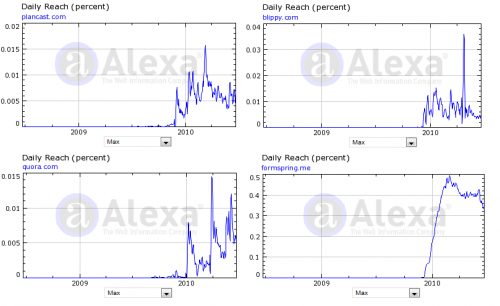
 So far this year we have seen a number of new companies spring forth like lovely spring flowers, well nourished by high-profile angles and venture capitalists, and founded by brand name people technologists. From the bystander’s perspective, there was money moving and smart people doing big things with it. This was an excellent, well-lauded reality.
So far this year we have seen a number of new companies spring forth like lovely spring flowers, well nourished by high-profile angles and venture capitalists, and founded by brand name people technologists. From the bystander’s perspective, there was money moving and smart people doing big things with it. This was an excellent, well-lauded reality.
Companies like Plancast, Blippy, Quora, and FormSpring launched in near unison and rode their initial traffic bursts together. The companies found this first explosion in users between December of 2009, and January of 2010. Traffic continued to rise as hype (coming from every technology rag under the sun) propelled them higher, and higher. These companies all had everything that anyone could hope for in a startup, but was it enough?
Based on the data that we have access to, each of the those companies has in the last few months stumbled into a traffic quandary, with slipping numbers throwing their buzz, funding, and potential into question. Look at the two graphs for the raw data that we will begin with. You can find higher resolution versions of those graphs here, and here.


Now, the graphs line up with what we have said thus far, that in late 2009 and early 2010 these four companies grew like weeds. You will note, the companies found their traffic peaks in March and April only to decline since. Not very heartening.
Before we can move forward, we need to bring in more data at the risk of giving Compete far more credit than it deserves. Below are four graphs of the four companies’ traffic numbers as reported by Alexa. With one simply explainable exception, both sources (Compete and Alexa) agree nearly perfectly:

A few trends have been outlined on those charts to make them more readable. Note the upward tick in the last few days of Quora’s traffic:

Look at the last set of graphs, and compare it to the Compete data. Surprisingly similar? A quick word on why the Compete and Alexa data on Quora don’t line up and and we can begin to draw conclusions. If you are a regular reader of TNW (and you real ly should be), you may have noticed a post that I wrote the other day entitled “Did Quora Leave Private Beta A Day Early?” That is the reason why Quora’s numbers have picked up in the last few day and the company reached a major milestone. We are dealing with data in a larger time context, so the slight uptick is not important. Compete reports on a monthly basis, and so has yet to report the rise. Note that this recent rise for Quora did not match past traffic spikes, and that it quickly fell off again. Not very impressive.
The data seems to be plain: these four startups, each dealing with social sharing in one form or another, have found it difficult to secure an audience outside of the tech sphere. They never found a real audience. That is to say, we Twitter-types will join anything to try it, and that does not a real userbase make. I joined all four startups, and now use none of them. Sam Sethi said it well: “big star names running them, lots of VC money but no real value (for me).” Is that the problem?
Money Over Bullshit
So said Nas, and in the business world you have to agree. Do these startups create enough value that is hard to replicate by another company to hold my interest and not be reproduced by a product that I already use? Formspring is anonymous questions, which can be done by a Facebook application in short order. Quora is a high class version of Yahoo Answers; I don’t need it. Plancast is noisy and trend based, and not very useful; the people whose plans I care about I just call. And finally Blippy is far too personal for most people, the security debacle aside.
It seems that each of the companies did not create the a compelling enough scenario for users, and the numbers show it.
#Oversharing
I have a sneaking suspicion that people, forced gently by Facebook to erode their own privacy, are all shared out. Between Twitter and Facebook, how many more services do you want to join to give away more of you? One? Two? Three?
The answer it seems from these charts is four, for about three weeks. People are playing with new tools when they launch and then letting them go. As Eminem said, “yesterday’s news.” After all, they are, literally.
What Comes Next
I hope that I am wrong about each and every one of these companies. I hope that each is a breakout success, but the data says otherwise. Each company is out to do something specific, and needs to do a better job pitching to the pub. Formspring has done the best job, and exploded to many times the usership of the other three companies, but has been met with the exact same issues. This is not a ‘critical mass’ issue, Formspring had that: it is a crisis of capability.
The companies would do well by adding new layers of functionality to their products that widened their scope, thus making them more useful and harder to clone by Facebook, which is always a lurking possibility.
But you are the deciding factor in the success and failure of these firms, you are the user. It is up to you. Do you use them? Which ones? How often, and for how long? Sound off in the comments. Let’s hope the information that we have is merely a short dip in an otherwise huge future, whatever the odds.
Get the TNW newsletter
Get the most important tech news in your inbox each week.





